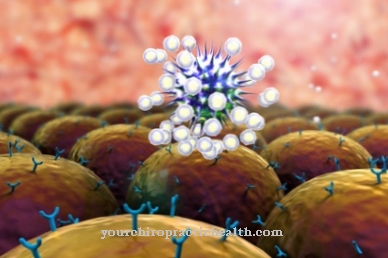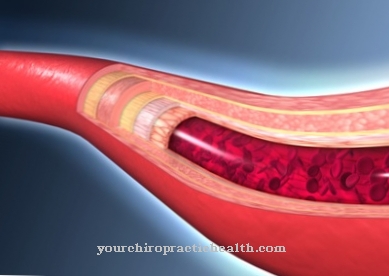All life comes from the sea. Hence there are conditions in the body that build on these original living conditions. This means that vital building blocks in the organism are salts. They enable all physiological processes, are part of the organs and form ions in aqueous solution. Sodium and potassium chloride are the dominant salts in the cells. In ionic form, they are the driving force for protein functions, determine the osmotically active components between the cell interior and external conditions and cause electrical potentials. One such is the membrane potential.
What is the membrane potential?

All cells have the property of developing a membrane potential. A membrane potential is understood to be the electrical voltage or potential difference between the outside and the inside of a cell membrane. When concentrated electrolyte solutions of a membrane are separated from one another and the conductivity in the membrane for ions is present, a membrane potential occurs.
Biological processes in the body are extremely complex. The membrane potential plays a crucial role, especially for muscle and nerve cells, as well as for all sensory cells. In all of these cells the process is at rest. The cells are only activated by a certain stimulus or excitation and the voltage changes. The change takes place from the resting potential and returns to it. In this case, one speaks of a depolarization.
This is the decrease in membrane potential due to electrical, chemical or mechanical effects. The voltage change takes place as an impulse, is passed on along the membrane, transmits information in the entire organism and enables communication between the individual organs, in the nervous system and with the environment.
Function & task
The cell in the human body is excitable and consists of sodium ions in so far as they are extracellular. Few sodium ions are present intracellularly. The imbalance between the inside and outside of the cell creates a negative membrane potential.
Membrane potentials are always negatively charged and have constant and characteristic values in the individual cell types. They are measured with microelectrodes, one of which leads inside the cell and the other is located as a reference electrode in the extracellular space.
The cause of a membrane potential is the difference in concentration of the ions. This means that electrical voltage builds up across the membrane, even if the net distribution of positive and negative ions is the same on both sides. A membrane potential is created because the lipid layer of the cell allows ions to accumulate on the membrane surface, but cannot penetrate through non-polar areas. The cell membrane has insufficient conductivity for the ions. This creates a high diffusion pressure. Not only as a whole, every single cell has electrical conductivity. The diffusion pressure then leads to the passage from the cytoplasm.
As soon as a potassium ion flows out under these conditions, positive charge is lost in the cell.This is why the inner membrane surface is negatively charged in order to create a balance. This creates an electrical potential. This increases with every change of side of the ions. This in turn reduces the concentration gradient of the membrane and, as a result, the diffusion pressure of the potassium. The outflow is interrupted and an equilibrium is created again.
The level of a membrane potential differs from cell to cell. As a rule, the cell behaves negatively to the outside of the cell and varies in the order of magnitude between (-) 50 mV to (-) 100 mV. In smooth muscle cells, on the other hand, smaller membrane potentials with (-) 30 mV arise.
As soon as the cell expands, which is the case in muscle and nerve cells, the membrane potential also differs spatially. There it serves primarily as propagation and signal transmission, while it enables information processing in the sensory cells. The latter happens in the same form in the central nervous system.
In the mitochondria and chloroplasts, the membrane potential is an energetic coupling between the energy metabolism processes. Ions are transported against the voltage. A measurement is difficult under such conditions, especially if it is to take place without mechanical, chemical or electrical interference.
Other conditions occur in the exterior of the cell, i.e. in the extracellular fluid. There are no protein molecules there, which is why the ratio is reversed. The protein molecules have a high conductivity, but cannot pass through the membrane wall. Positive potassium ions always strive to balance the concentration. This creates a passive transport of the molecules in the extracellular fluid.
This process continues until the electrical charge that has built up is in equilibrium again. In this case there is a Nernst potential. This means that a potential can be calculated for all ions, since the size depends on the concentration gradient on both sides of the membrane. In the case of potassium, the magnitude is (-) 70 to (-) 90 mV under physiological conditions, and in the case of sodium around (+) 60 mV.
Illnesses & ailments
The level of the membrane potential characterizes the general health of the cells. A healthy cell is on the order of (-) 70 to (-) 90 mV. The flow of energy is strong, the cell is strongly polarized. Fifty percent of the subtle energy is used for polarization. The membrane potential is therefore high.
It looks different with a diseased cell. Due to the low-energy area, it needs subtle energy from its environment. In doing so, it either swings horizontally or turns to the left. The membrane potential of these cells is very low, as is the cell vibration. Cancer cells e.g. B. only have a magnitude of (-) 10 mV. The susceptibility to infection is therefore very high.


.jpg)










.jpg)

.jpg)
.jpg)










